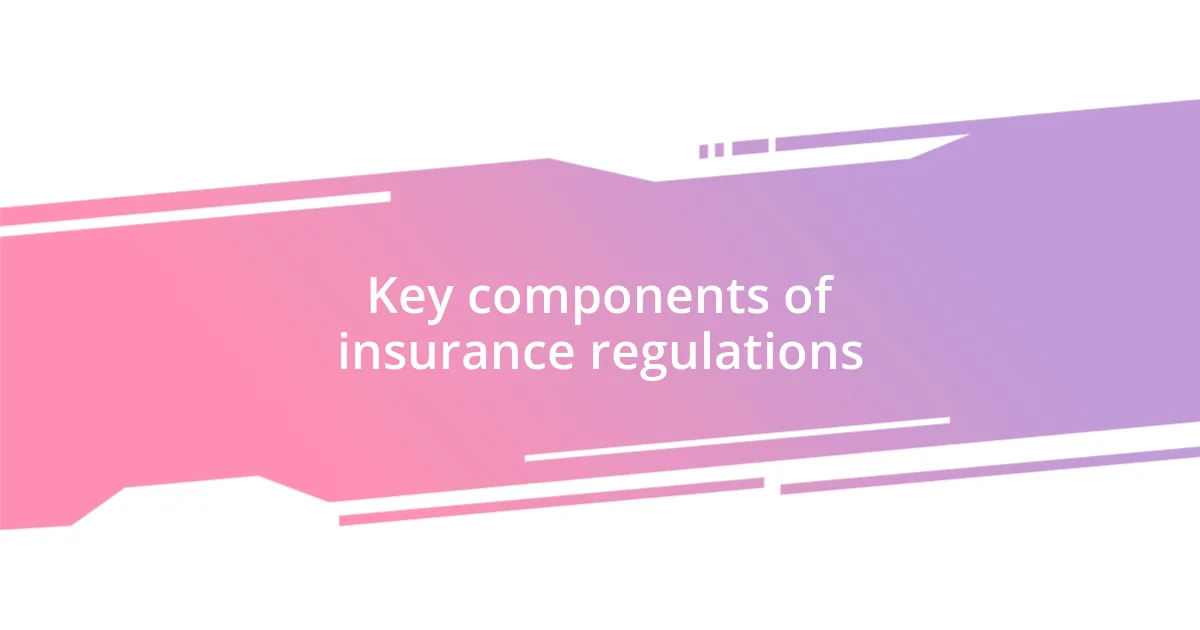Key takeaways:
- Insurance regulations are essential for consumer protection, accountability, and promoting market competition, ensuring policyholders can trust insurers.
- Recent regulatory changes focus on transparency, such as clearer disclosure of coverage details and justifications for rate increases, enhancing consumer experience.
- Future trends include personalization through data analytics, sustainability initiatives, and the use of blockchain technology for improved efficiency and transparency in the insurance industry.

Understanding insurance regulations
Understanding insurance regulations can feel overwhelming, but it’s crucial to grasp their fundamental purpose. I still remember the first time I navigated the complex web of rules for a small business I was involved with. It struck me how these regulations not only protect consumers but also ensure fair practices across the insurance industry.
Have you ever wondered why there are so many different types of insurance products? Each regulation stems from a specific need, whether it’s safeguarding against natural disasters or ensuring health coverage. I often find myself reflecting on how regulations evolve; they must adapt to changes in society, technology, and the economy. For instance, when telemedicine surged, insurance guidelines needed to support this new era of healthcare access.
It’s fascinating to think about the balance regulators try to achieve. They aim to protect consumers without stifling innovation in the insurance market. I recall a discussion with an insurance broker who emphasized that while regulations can sometimes seem burdensome, they ultimately foster trust. Isn’t that what we all want in our financial transactions?

Importance of insurance regulations
Insurance regulations serve as a crucial safety net for consumers. I can still picture the sense of relief I felt when I discovered that regulations ensure insurers have the financial stability to honor claims. It’s reassuring to know that these rules mandate companies to maintain sufficient reserves to pay out claims, allowing individuals and businesses to confidently invest in their future.
Moreover, regulations foster a climate of accountability in the insurance sector. During one of my early experiences as a policyholder, I encountered a situation where I had to file a claim for damages after a storm. It was comforting to understand that oversight bodies were in place, ensuring that insurers couldn’t unjustly deny claims or engage in unfair practices. Doesn’t it feel empowering to know there’s a layer of protection for policyholders that holds insurance companies accountable?
Lastly, these regulations promote competition. I remember discussing with a friend who recently switched insurance providers for a better rate. The reason behind this shift was not just price but also the assurance that different companies had to meet specific regulatory standards. This not only benefits consumers by providing them with various options but also encourages innovation within the industry to attract customers.
| Impact of Regulations | Description |
|---|---|
| Consumer Protection | Ensures financial stability of insurers and protects policyholders’ rights. |
| Accountability | Requires insurers to adhere to fair practices and handle claims appropriately. |
| Market Competition | Encourages insurers to innovate and offer better products and prices. |

Key components of insurance regulations
The landscape of insurance regulations is shaped by several key components that ensure a robust framework for both consumers and insurers. One part that stands out to me is the emphasis on financial solvency. I once found myself in a conversation with a financial planner who explained how regulations require insurance companies to maintain certain reserve levels. This essentially acts as a safety net for policyholders, ensuring that even in times of crisis, companies have the means to pay out claims. It’s a comforting thought to know that there’s a buffer in place.
Here are some key components of insurance regulations:
- Consumer Protection Laws: Safeguard policyholders’ rights and ensure fair treatment.
- Financial Requirements: Mandate insurers to maintain sufficient reserves for claims.
- Licensing: Ensure that only qualified entities can offer insurance products, maintaining industry integrity.
- Rate Approval Processes: Control how much insurers can charge for their products, preventing price gouging.
- Claims Handling Rules: Set standards for how claims are processed and paid out, ensuring transparency and fairness.
Additionally, I can’t help but remember a time when I was reviewing various health insurance plans. The regulatory framework provided clear benchmarks to compare offerings, making my decision less daunting. I appreciated how regulations often require plans to disclose information such as coverage limits and exclusions. It made me feel empowered to choose wisely based on my needs rather than being overwhelmed by marketing jargon.

Recent changes in insurance regulations
Recent shifts in insurance regulations have made notable strides towards transparency and consumer advocacy. I remember feeling quite relieved after hearing about a new policy that mandates clearer disclosure of coverage details in auto insurance. It’s so frustrating to wade through technical jargon without truly understanding what you’re signing up for. Doesn’t it feel much better to have all necessary information laid out plainly?
Another significant change is the heightened scrutiny of rate increases. Just a few years back, seeing a hike in my premiums felt like an unavoidable burden. Now, regulations often require insurers to provide justifications for their rate increases, which has instilled a sense of fairness in the process. It’s comforting to think that, as consumers, we’re no longer in a position of helplessness against sudden cost spikes.
Additionally, the focus on digital innovation in the regulatory space has really caught my attention. The rise of online claims processing has transformed my experience when reporting a claim. I vividly recall filing a claim for a minor accident through a mobile app, which felt remarkably straightforward. Wouldn’t it be great if every process in insurance could be just that seamless? These regulatory updates promise to deliver a more user-friendly experience, making insurance more accessible and less daunting for everyone involved.

Impact of regulations on consumers
The impact of regulations on consumers is profoundly significant, shaping the experience of purchasing and utilizing insurance products. I remember shopping for homeowners insurance and coming across policies with clear descriptions of coverage. Regulations often dictate these disclosures, significantly reducing my anxiety about making the right choice. Isn’t it refreshing to know exactly what your policy covers without hidden terms?
Moreover, I found that regulations fostering fair claims handling have made a huge difference in my peace of mind. I once filed a claim for water damage, and the standardized processes created by these regulations eased the tension that usually accompanies such situations. When I received prompt communication about the status of my claim, I couldn’t help but feel grateful for the extended consumer protections. Don’t you agree that knowing your rights are backed by regulations empowers you as a policyholder?
Finally, the recent emphasis on affordability due to stringent rate approval processes has certainly resonated with me. I recall a time when my car insurance renewal brought a wave of anxiety over potential price surges. Regulations now require insurers to justify their rates, making them more accountable to consumers. This level of oversight creates an environment where I feel safer as I navigate the world of insurance. Have you experienced the relief of knowing that a regulatory body is holding insurers accountable for their pricing strategies? It certainly uplifts my confidence in being a savvy consumer.

Compliance strategies for insurance companies
One effective compliance strategy for insurance companies revolves around fostering a culture of transparency. I remember attending a workshop where a compliance officer shared insights on how open communication can enhance relationships with regulators. It’s fascinating how so many companies often overlook the power of being proactive in sharing their practices, especially when they can maintain a strong dialogue about their policies and rate changes. Doesn’t it make you feel more at ease to know that a company is not hiding anything from you?
Investing in ongoing staff training is another crucial component. During my time working with insurance professionals, I saw firsthand how understanding the latest regulations could directly impact their interaction with clients. When agents are well-informed, they can better explain policy nuances and compliance updates, which ultimately builds trust. Have you ever felt more secure dealing with someone who truly understands the ins and outs of their field? It’s that sense of assurance that keeps clients returning.
Lastly, leveraging technology to streamline compliance tracking can’t be overlooked. I’ve seen companies implement innovative software that automates regulatory updates and monitors adherence, reducing the burden of manual checks. This not only saves time but also minimizes the risk of non-compliance. Don’t you think it’s a game-changer when technology helps maintain standards while allowing staff to focus on customer service? It’s a win-win for both the company and the policyholder.

Future trends in insurance regulations
I’m excited to share my thoughts on the future trends in insurance regulations, as these changes have the potential to reshape the industry in remarkable ways. One of the most compelling trends I see is the shift towards personalization in insurance offerings, driven by advanced data analytics. Just think about the last time you received tailored recommendations for a product you were interested in. Now, imagine insurers using similar technology to customize coverage based on individual behaviors and needs. Doesn’t it feel right when companies strive to provide service that truly reflects who you are as a person?
Another significant trend is the increasing focus on sustainability and environmental considerations in regulatory frameworks. I once attended a panel discussion on this topic, and it struck me how insurers can play a pivotal role in promoting eco-friendly practices through incentives or discounts. If regulations start to encourage greener policies, it sets the stage for a future where being environmentally conscious can also lead to financial benefits. Have you ever thought about how your choices could contribute to a larger goal, like combating climate change through insurance? It’s inspiring to imagine that our personal decisions could interplay with broader regulatory efforts.
Lastly, the incorporation of blockchain technology for automating processes and enhancing transparency is a game changer on the horizon. A friend of mine in the industry shared a fascinating anecdote about how a blockchain pilot program dramatically sped up claims processing. I couldn’t help but feel a rush of optimism at the thought of transparency wrapped up in technology, minimizing the dreaded back-and-forth with claims adjusters. Is it exciting to think that such innovations could revolutionize how we see accountability in insurance? I firmly believe that this could pave the way for a more trust-filled relationship between insurers and policyholders, and that feeling is something we all can appreciate.














